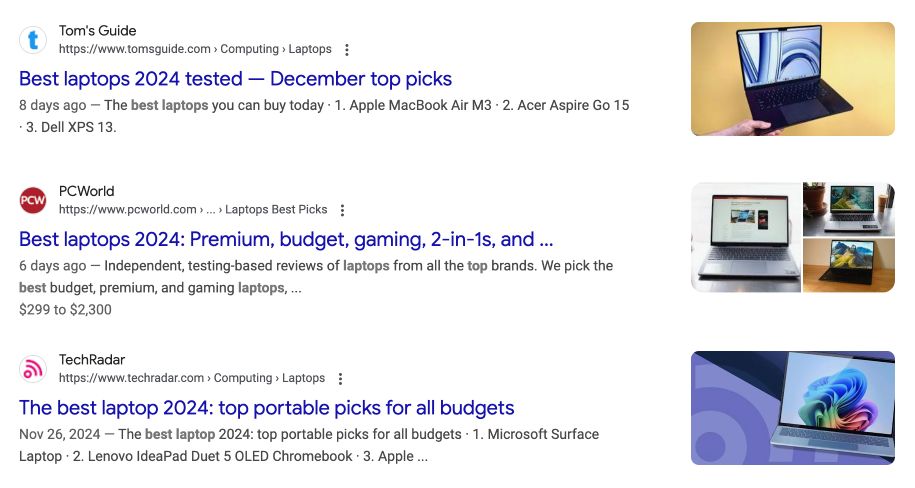TL;DR: Understanding user search intent allows you to match the content you write with the answer or solution a searcher is looking for. If you properly align the search intent with your posts’ keywords, it can play a key role in boosting your SEO visibility.
- What is search intent?
- How to use search intent in SEO success
- Planning for intent
- Keyword research
- Confirming intent
- Using tools for help
When a person carries out a search, there’s always a specific purpose behind it—and the words they use influence the results that show up. For the searcher, they have a clear idea of what they want and it’s in Google’s interest to show them those results.
But achieving this is more difficult than it may seem and Google has spent years developing its algorithm to determine and respond to search intent.
For businesses, this presents an opportunity as showing up at the right time for the right search can make a huge difference in conversions. After all, if your solution is the exact answer that someone is looking for at that precise moment in time, you’re more likely to make a sale.
To achieve this, you need to understand the role of search intent in SEO and how to optimize for it.
What is search intent?
At its most basic level, search intent refers to the purpose behind a search. If you begin a search with “what is,” you’re looking for information. If you type in “where to buy,” you likely want to make a purchase.
In the early days of the internet, the keyword you used was the only determining factor in the results that showed up. Since it didn’t take intent into account, there was a certain amount of luck involved as to whether you would find what you were looking for or not.
As search engines and the theory behind them evolved, the role of intent became evermore nuanced. Nowadays, we generally put search intent into four categories (plus one extra, depending on how you classify it).

Informational intent
More often than not, when someone carries out a search, they’re looking for information. The specific topic can be literally anything but the intent remains the same—they want to find out something.
For example, if someone searches for “bee sting,” what could the search intent be behind it? With intent taken into account, it’s likely that someone who searches for “bee sting” has recently been stung by a bee and wants to identify the reaction or know how to stop the pain.
In short, they want information.
Navigational intent
Next we have navigational intent, which is when someone wants to visit a specific website. There are two reasons this is important for you as a business owner. The first is that you need to make sure your business’ name shows up when people search for it.
Provided your website isn’t entirely new, has been properly indexed, and you’re following SEO best practices, you should be able to rank for your own brand name. It’s also a good practice to register for as many citation/indexing sites as possible, such as Yelp, Yellow pages, White Pages, Bing, etc., as this will make it easier for Google and other search engines to find you.
Most businesses find they are able to rank for their own brand name without too much effort, but that isn’t the end of the story. Navigational intent should also be taken into account when creating posts with keywords that others might be searching for with navigational intent.
Say you manage to rank highly for the keyword “Hubspot.” Hubspot is a well-known CRM platform and anybody who searches directly for that term is looking for that company. If you rank for that keyword, it won’t harm you… But it won’t do any good. Even if you’re number one in the search results, you’ll probably find you’re still not converting any of the visitors. And the reason for that is navigational intent.

Transactional intent
If you own an ecommerce site, this is one to keep an eye out for! Transactional intent is when people search with the express intent to buy something at that moment in time. Generally, they already know what they want to buy and the search will be geared towards getting them there.
For example, instead of searching for “Rolex watches,” which implies they want to research the brand, they may search for “Rolex AIR-KING Oyster, 40 mm.” They know exactly what type of Rolex they want, and are likely to make a purchase.
Whatever your ecommerce site sells, ranking on Google for the product terms is a surefire way to boost your sales.
Commercial investigation
This can be considered a bridge between informational and transactional intent, when the searcher is still exploring options and carrying out research. They have likely already made up their mind that they want to purchase a product or service, but they aren exactly sure which yet.
It could be “best laptops this year” or “What SEO management platform works the best?” Since the intent here is research, the types of posts that usually do well are list articles. If you’re selling laptop computers, and someone searches for “best laptops,” the name of your article might include: “10 Best Laptops of 2024.”
As a test, let’s see what comes up when we search for that “best laptops”:

Every one is a list article, which means if you want to rank for the same keyword, you’ll likely need to write a listicle.
Local intent
Finally, we have local intent, which can almost be considered a subgenre of search intent on its own. We go into more detail on this in our article on how to create a Google Business Profile, but essentially local intent is when the physical and the virtual merge.
Whether you search for a physical location or add “near me” at the end of the search, your intent is to find a physical place (whether a store, attraction, or point of interest, etc.) that you are likely to visit.
How to use search intent in SEO success
It’s not just enough to know what search intent is, you also need to know how to use it to your advantage. Local intent will be covered almost entirely by creating and optimizing a Google Business Profile and navigational searches should be covered by ensuring your technical SEO foundations are in place and you’re generally following best practices. But the others require a concerted strategic SEO approach to take advantage of their potential.
1) Planning for intent
As we said before, navigational intent should be taken care of semi-automatically and local intent is covered by your Google Business Profile. That means you need to provide content for transactional, commercial and informational intent.
People who find your website are going to have different intentions depending on the situation. It’s your job to ensure that your content fulfills everyone’s needs regardless of their intent at that moment in time.
Transactional/commercial intent
If visitors have the intention of making a transaction or researching a product thoroughly, you need to provide content that convinces them that you are worth spending money on. In marketing terms, this is known as bottom-of-the-funnel content. Unless you have this type of content, no amount of SEO success is going to help you as visitors will come, find the information they want, and then go elsewhere to make the purchase.
So, before worrying about informational intent, prepare for transactional as these are the people who are actually going to make you money. Some good types of content for this are:
- Case studies
- Best product posts (lists)
- Product reviews
- Product Vs Product posts (i.e. WooCommerce vs Shopify: Which is better for my business?)
Informational intent
Once you have a few quality transactional posts in place, you need to start thinking about informational intent. These are the posts people search when they are doing research or want to find out more about a topic. They are hard to rank for but, if you do, the long-term impact on your traffic is immense.
Common examples include:
- How to posts
- Idea posts
- What is posts
- Providing templates
- Examples of X posts
2) Keyword research
Now you know the types of posts you need, but the next question is—what do you write about?
As part of your SEO strategy, you’ll likely have done keyword research and should know what the most important keywords are for your business. By taking these keywords and adding specific tails, you can further tailor them to the intent.
If it’s transactional intent, it would be words such as: “buy, deal, or discount.” The product names themselves are also inherently transactional in nature.
For informational searches, common words are “information, how to, best way to, why.” While there are no statistics available, we can assume that the vast majority of the 5.6 billion searches carried out every day are informational. Generally, we search to find things out more often than we actually make purchases. This means that informational searches can take a huge number of forms and the example words provided are far from exhaustive.

3) Confirming intent
Once you have your ideal keywords, with or without their tails, there’s a very simple way to see if the intent you imagine corresponds to reality. In fact, we’ve done it a few times in this post already.
The “trick,” if you want to call it that, is to simply Google it. If you search for your keyword, what kinds of links come up? Are they similar to what you were going to write? Would your business be the answer to the questions inherent in the top 10 results?
What comes up represents the search intent for that topic. So, to fulfill the intent, you need to write similar but better articles. This may mean adding more length as it’s hard for a “Top 5 X” post to outrank a “Top 10 X” post but it’s not the only way to do it. You can combine a listicle with free assets or find another way to provide value. The important takeaway is that your article must fulfill the search intent for the user better than the original articles so that, with time and active link-building efforts, the search engine will perceive it as being more valuable.
4) Using tools for help
The above method works surprisingly well to help you find content. But there’s quite a bit of luck involved as you don’t have any data to work with, don’t know how competitive anything is, etc.
Luckily, there are tools to help you zone in on the informational content that will be most useful for you.
The Competitor Method
We all have competitors and as a business owner, you should know yours. Take whatever blog you’re competing with and go to semrush.com. On the menu, you will see an option for “Backlink Analytics” under “Link Building”. Click it and you will see a box to type in your competitor.
Once the competitor comes up, click “Indexed Pages” in the top menu bar on the page. Here you will see their most successful posts in terms of links.
Look at those posts and write better ones. If they work for your competitor, they can work for you too!
Please note that SEMrush is a paid tool and you will only be able to carry out one search a day for free. You will also need to engage in separate link building efforts to encourage people to link to you.
The Watchdog Studio Method
If all this sounds like too much to keep track of, there are other solutions out there. For example, our SEO management platform provides everything you need to understand what your competitors are doing and the intent behind each search.
When setting up your strategy, you will input a number of competitors into the system. The platform will then automatically follow them and the keywords that are most successful for them—which can be used to be successful for you.
The platform also suggests backlink opportunities, content ideas, tutorials on how to choose the right content, and more. In short, everything you need to understand intent, create tailored content, and make that content work for you is all under one roof.
If you’d like to find out more information about how the SEO management platform ensures every aspect of your SEO strategy is in your control, reach out today. In a short call, we can go through the platform’s main features and answer any questions you may have.


